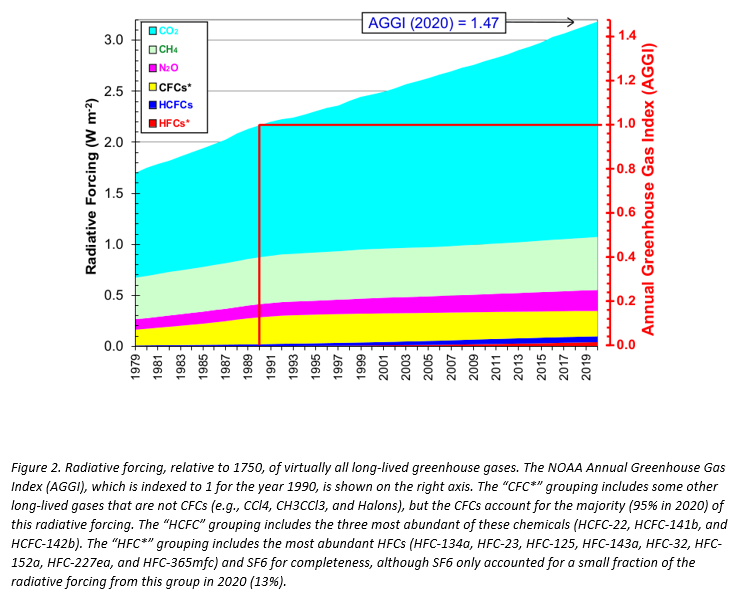2020: HFCs CONTRIBUTE 1.13% TO CLIMATE WARMING INFLUENCE OF GREENHOUSE GASES
The US NOAA (National Oceanic and Atmospheric Administration) has released its 2020 update of the AGGI (Annual Greenhouse Gas Index), which follows the evolution of the radiative forcing (ability of all greenhouse gases to trap heat) since the onset of the industrial revolution. The HFC impact in 2020 is now 1.13% of the total (compared to 1.08% in 2019). In total CO2, CH4, N2O, CFC-12 and CFC-11 account for about 96% of the direct radiative forcing by long-lived greenhouse gases since 1750, with the contribution due to CO2, CH4 and N2O about 89% and CFC-11 and CFC-12 about 7%. Carbon dioxide CO2 has accounted by far the biggest contributor to increases in climate forcing since 1990. While the radiative forcing from HFCs has been small relative to other greenhouse gases, the potential for large future increases led to the adoption of controls on HFC production in the Kigali amendment to the Montreal Proto col. Figure 1 shows the trend in atmospheric concentration for HFC-134a, the most widely used HFC, compared to other greenhouse gases.
The Annual Greenhouse Gas Index (AGGI) is calculated as the ratio of total direct radiative forcing due to these gases in a given year to its total in 1990. 1990 was chosen because it is the baseline year for the Kyoto Protocol and the publication year of the first IPCC Scientific Assessment of Climate Change. Most of this increase is related to CO2. For 2020, the AGGI was 1.47 (representing an increase in total direct radiative forcing of 47% since 1990). This is shown in Figure 2.
The 2020 annual methane increase in atmospheric methane concentration was the largest annual increase recorded since 1983 when NOAA's ongoing measurements began. The atmospheric burden of nitrous oxide continues to grow over time. Furthermore, the annual increase in nitrous oxide's atmospheric burden, averaging 1.0 ppb/yr over the past decade, is also increasing. The annual increase in 2020 was the largest recorded since measurements began. Radiative forcing from the sum of observed CFC changes ceased increasing in about 2000 and has continued to decline ever since. This continued decline is a response to global controls placed on CFC production and trade by the adjusted and amended Montreal Protocol on Substances that Deplete the Ozone Layer.
NOAA Global Monitoring Laboratory - THE NOAA ANNUAL GREENHOUSE GAS INDEX (AGGI)
Explanatory note : Radiative forcing is the change in the net, downward minus upward, radiative flux (expressed in Watts per square metre; W m-2) at the tropopause or top of atmosphere due to a change in an external driver of climate change, such as, for example, a change in the concentration of carbon dioxide (CO2) or the output of the Sun. For the purposes of the WG1 AR5 report, radiative forcing is further defined as the change relative to the year 1750 and, unless otherwise noted, refers to a global and annual average value.

